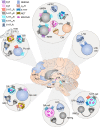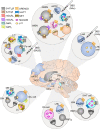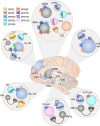Update on GPCR-based targets for the development of novel antidepressants
- PMID: 33589739
- PMCID: PMC8960420
- DOI: 10.1038/s41380-021-01040-1
Update on GPCR-based targets for the development of novel antidepressants
Abstract
Traditional antidepressants largely interfere with monoaminergic transport or degradation systems, taking several weeks to have their therapeutic actions. Moreover, a large proportion of depressed patients are resistant to these therapies. Several atypical antidepressants have been developed which interact with G protein coupled receptors (GPCRs) instead, as direct targeting of receptors may achieve more efficacious and faster antidepressant actions. The focus of this review is to provide an update on how distinct GPCRs mediate antidepressant actions and discuss recent insights into how GPCRs regulate the pathophysiology of Major Depressive Disorder (MDD). We also discuss the therapeutic potential of novel GPCR targets, which are appealing due to their ligand selectivity, expression pattern, or pharmacological profiles. Finally, we highlight recent advances in understanding GPCR pharmacology and structure, and how they may provide new avenues for drug development.
© 2021. The Author(s).
Conflict of interest statement
The authors declare no competing interests.
Figures




Similar articles
-
GPCR oligomerization as a target for antidepressants: Focus on GPR39.Pharmacol Ther. 2021 Sep;225:107842. doi: 10.1016/j.pharmthera.2021.107842. Epub 2021 Mar 19. Pharmacol Ther. 2021. PMID: 33746052 Review.
-
Structural insights into ligand recognition and selectivity for classes A, B, and C GPCRs.Eur J Pharmacol. 2015 Sep 15;763(Pt B):196-205. doi: 10.1016/j.ejphar.2015.05.013. Epub 2015 May 14. Eur J Pharmacol. 2015. PMID: 25981303 Free PMC article. Review.
-
New agents and perspectives in the pharmacological treatment of major depressive disorder.Prog Neuropsychopharmacol Biol Psychiatry. 2021 Mar 2;106:110157. doi: 10.1016/j.pnpbp.2020.110157. Epub 2020 Nov 5. Prog Neuropsychopharmacol Biol Psychiatry. 2021. PMID: 33159975 Free PMC article. Review.
-
Exploring Novel Antidepressants Targeting G Protein-Coupled Receptors and Key Membrane Receptors Based on Molecular Structures.Molecules. 2024 Feb 22;29(5):964. doi: 10.3390/molecules29050964. Molecules. 2024. PMID: 38474476 Free PMC article. Review.
-
New approaches to the pharmacological management of major depressive disorder.Adv Pharmacol. 2009;57:347-79. doi: 10.1016/S1054-3589(08)57009-8. Epub 2009 Nov 27. Adv Pharmacol. 2009. PMID: 20230766 Review.
Cited by
-
Dysfunctional Heteroreceptor Complexes as Novel Targets for the Treatment of Major Depressive and Anxiety Disorders.Cells. 2022 Jun 2;11(11):1826. doi: 10.3390/cells11111826. Cells. 2022. PMID: 35681521 Free PMC article. Review.
-
Understanding the mechanism of action and clinical effects of neuroactive steroids and GABAergic compounds in major depressive disorder.Transl Psychiatry. 2023 Jun 26;13(1):228. doi: 10.1038/s41398-023-02514-2. Transl Psychiatry. 2023. PMID: 37365161 Free PMC article. Review.
-
TAARs as Novel Therapeutic Targets for the Treatment of Depression: A Narrative Review of the Interconnection with Monoamines and Adult Neurogenesis.Biomedicines. 2024 Jun 6;12(6):1263. doi: 10.3390/biomedicines12061263. Biomedicines. 2024. PMID: 38927470 Free PMC article. Review.
-
Learning interpretable cellular and gene signature embeddings from single-cell transcriptomic data.Nat Commun. 2021 Sep 6;12(1):5261. doi: 10.1038/s41467-021-25534-2. Nat Commun. 2021. PMID: 34489404 Free PMC article.
-
A bipolar disorder-associated missense variant alters adenylyl cyclase 2 activity and promotes mania-like behavior.Mol Psychiatry. 2025 Jan;30(1):97-110. doi: 10.1038/s41380-024-02663-w. Epub 2024 Jul 13. Mol Psychiatry. 2025. PMID: 39003412 Free PMC article.
References
Publication types
MeSH terms
Substances
LinkOut - more resources
Full Text Sources
Other Literature Sources

